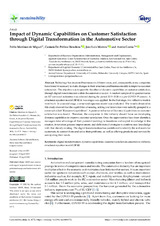Impact of Dynamic Capabilities on Customer Satisfaction through Digital Transformation in the Automotive Sector
Autor
Martínez de Miguel, Pablo
Pablos-Heredero, Carmen de
Montes, José Luis
García Martínez, Antón Rafael
Editor
MDPIFecha
2022Materia
Digital transformationDynamic capabilities
Customer satisfaction
Automotive industry
Structural equation model (SEM)
METS:
Mostrar el registro METSPREMIS:
Mostrar el registro PREMISMetadatos
Mostrar el registro completo del ítemResumen
Technology has impacted businesses in different areas, and, consequently, many companies have found it necessary to make changes in their structures and business models to improve customer satisfaction. The objective was to quantify the effect of dynamic capabilities on customer satisfaction, through digital transformation within the automotive sector. A random sample of 42 questionnaires on 127 surveyed industries was collected during the period 2019–2020 in a pre-COVID-19 context. A structural equation model (SEM) in two stages was applied. In the first stage, two reflective models were built. In a second stage, a structural equation model was evaluated. The results obtained in this study showed that the capabilities of sensing, seizing and innovation were suitably grouped in a construct called “Dynamic Capabilities”. A positive influence of Dynamic Capabilities on customer satisfaction was found. Therefore, the companies in this industry should focus on developing dynamic capabilities to improve customer satisfaction. Once the opportunities have been identified, managers take advantage of their potential (seizing) to transform and exploit knowledge in the creation, innovation, process improvement, and definition of strategies to combine new knowledge with that already existing. The digital transformation has contributed to identify the real needs for customers, to contact them and solve their problems, as well as offering products and services by anticipating their needs.

